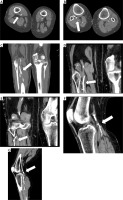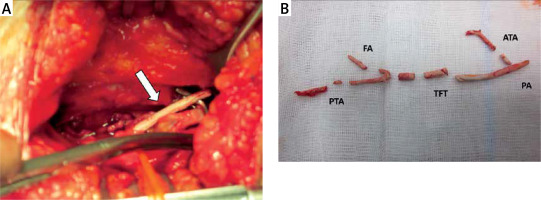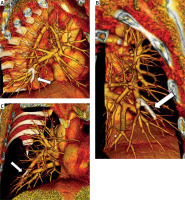Cement embolism is an infrequent yet potentially serious complication encountered in spinal surgeries. In recent years, minimally invasive spinal surgeries, such as vertebroplasty and kyphoplasty, have emerged as effective techniques for managing vertebral compression fractures or spinal metastases, offering notable benefits in pain relief and functional restoration for patients [1]. However, the inadvertent extravasation of cement beyond the vertebral body can lead to embolization into adjacent vasculature, resulting in arterial or venous occlusion at distant sites. While venous embolism is more frequently documented, arterial embolism, though less common, presents with acute limb ischemia symptoms, necessitating prompt recognition and intervention to prevent irreversible tissue damage and limb loss [2]. The diagnosis of cement embolism remains challenging due to its varied clinical presentations and the absence of specific diagnostic criteria [3]. Effective management strategies depend on factors such as the extent of embolization and the patient’s clinical condition, ranging from conservative measures to more invasive interventions [4]. In this report, we present two cases of cement embolism following spinal surgeries, highlighting the diagnostic dilemmas, therapeutic challenges, and outcomes associated with this complication. Additionally, we review the existing literature on arterial and venous cement embolisms after spinal procedures, emphasizing the importance of early recognition and appropriate management to mitigate the morbidity and mortality associated with this rare but significant complication.
A 53-year-old female with B-cell non-Hodgkin lymphoma and spinal metastasis presented with exacerbated pain in the left lumbar region, radiating to the ventrolateral thigh and knee, along with left hip flexor weakness. Magnetic resonance imaging revealed tumor infiltration in L3 with partial vertebral body sintering, posing a risk of spinal canal obstruction and neurological deficits. Subsequent surgery involved internal fixation from L2 to L4, with cement augmentation of screws in L3 using Palacos bone cement. Postoperatively, the patient experienced numbness and pain in the right foot and lower leg, limiting her walking distance to approximately 100 m. Four months later, she underwent consolidative high-dose MTX chemotherapy, during which she reported increasing pain in the right lower leg, especially on exertion. A duplex sonographic examination revealed suspected occlusion of the right popliteal artery by a foreign body, confirmed by computed tomography (CT) angiography showing a 4–5 cm blockage in the P2 segment with imaging suggestive of cement deposits (Figure 1). Attempts at endovascular removal of intravascular foreign bodies via digital substrate angiography (DSA) were unsuccessful, necessitating surgical intervention due to persistent critical ischemia (Figure 2). Intraoperatively, cement was palpable in the lower leg arteries, with chronic blockage of the 2nd and 3rd popliteal segments by organized thrombi. A longitudinal arteriotomy exposed the third popliteal segment and tibiofibular trunk, enabling removal of foreign bodies from lower leg artery branches (Figure 3). Vessel reconstruction was performed due to poor vessel wall condition. A segment of the great saphenous vein was harvested for grafting, facilitating anastomosis between the vein graft and posterior tibial artery below the knee joint. Additionally, the fibular artery was implanted into the vein graft, followed by an end-to-end anastomosis with a 6 mm Goretex ring-reinforced prosthesis which was end-to-side anastomosed with the first popliteal segment. Despite improved peripheral perfusion postoperatively, the patient experienced residual numbness in the right forefoot area. Anticoagulation therapy with heparin and Prostavasin was initiated postoperatively. Double antiplatelet therapy with aspirin and clopidogrel was also initiated. The postoperative duplex sonography showed a monophasic flow in the area of the distal superficial femoral artery, in the area of the popliteal artery as well as on the distal lower leg and on the foot. To further assess the bypass function, a DSA was performed and the femorocrural bypass was found to be occluded, probably due to poor peripheral flow (Figure 4). Given the absence of rest pain or open lesions, conservative management was continued. The patient was discharged in stable condition on the 17th postoperative day, with subsequent follow-ups revealing no deterioration in leg perfusion.
Figure 1
Computed tomography images revealing arterial occlusion of the lower limb by foreign bodies (arrows). A – Transverse images of the distal thigh showing the foreign body in the superficial femoral artery. B – Transverse images showing the foreign body at the knee level. C–E – Coronary reconstructions. F, G – Sagittal reconstructions

Figure 2
Angiography images showing the endovascular presence of foreign bodies. A, B – Endovascular presence of foreign bodies. C–F – Occlusion of the lower leg arteries

Figure 3
A – Removal of cement material (arrow) from the popliteal artery. B – Some of the removed parts of the foreign bodies
PA – popliteal artery, ATA – anterior tibial artery, TFT – tibiofibular trunk, FA – fibular artery, PTA – posterior tibial artery.

A 63-year-old female patient with a documented history of osteoporosis was admitted for cholecystectomy, during which she experienced a complex postoperative course necessitating multiple endoscopic retrograde cholangiopancreatographies (ERCPs). Subsequently, a few months following discharge, she sustained a traumatic fall resulting in fractures of the right 8th and 9th ribs and compression fractures of two lower thoracic vertebral bodies. In response to persistent symptoms, the patient underwent minimally invasive kyphoplasty to address the vertebral compression fractures. Despite initial intervention, symptomatology persisted, prompting a repeat kyphoplasty procedure one month later. Following these procedures, satisfactory spinal stability was achieved. One and two years post-kyphoplasty, the patient underwent additional ERCPs. Four years following the initial kyphoplasty, the patient was readmitted to the hospital for further evaluation due to a persistent fever of unknown etiology. Computed tomography of the thorax was performed as part of the diagnostic workup, revealing no evidence of infectious foci. However, incidental findings revealed an old pulmonary embolism with foreign body material lodged in the right lower lobe artery, identified as cement remnants from the prior kyphoplasty procedure performed four years earlier (Figure 5). Despite the incidental discovery of the pulmonary embolism, the patient remained asymptomatic with respect to respiratory symptoms. Conservative management was deemed appropriate, and treatment was directed towards addressing the underlying etiology of the fever, which was determined to be a urinary tract infection. Antibiotic therapy successfully resolved the infection, and post-discharge follow-up assessments did not reveal any respiratory abnormalities. The patient continued to receive conservative management for her pulmonary embolism without further intervention.
Figure 5
3D reconstruction of CT images showing the presence of foreign bodies in the pulmonary artery of the right lower lobe (arrow)

Cement embolism represents a rare but potentially severe complication associated with spinal surgeries, particularly procedures such as vertebroplasty and kyphoplasty. These minimally invasive techniques involve the percutaneous injection of bone cement into vertebral bodies to stabilize fractures or treat spinal pathology, offering significant benefits in pain relief and functional restoration [1]. However, the inadvertent extravasation of cement beyond the vertebral body can lead to embolization into adjacent vasculature, resulting in arterial or venous occlusion at distant sites [5]. In the presented cases, both arterial and venous embolisms occurred following spinal procedures, underscoring the diverse clinical manifestations and diagnostic challenges associated with cement embolism. Arterial embolism typically presents acutely with symptoms of limb ischemia, including pain, pallor, pulselessness, and paralysis, necessitating prompt recognition and intervention to prevent irreversible tissue damage and limb loss [2]. Conversely, venous embolism may remain asymptomatic or manifest as pulmonary embolism, leading to respiratory compromise and potentially life-threatening consequences [6]. The diagnosis of cement embolism can be challenging due to its varied clinical presentations and the lack of specific diagnostic criteria. Imaging modalities such as plain radiography, CT, magnetic resonance imaging (MRI), and angiography play crucial roles in confirming the diagnosis and delineating the extent of embolization. However, distinguishing cement embolism from other vascular pathologies or postoperative changes can be challenging, requiring a high index of suspicion and careful interpretation of imaging findings [7]. Management strategies for cement embolism depend on the clinical presentation, extent of embolization, and patient’s overall condition. Conservative measures such as anticoagulation and supportive care may suffice in asymptomatic or hemodynamically stable patients with venous embolism [8]. However, arterial embolism often necessitates more aggressive interventions, including surgical thrombectomy, endovascular procedures, or arterial reconstruction, to restore perfusion and prevent limb loss [2]. In the case of arterial embolism, prompt recognition and intervention are paramount to salvage ischemic limbs and prevent long-term morbidity. In our first case, despite attempts at endovascular removal of intravascular foreign bodies, surgical thrombectomy and arterial reconstruction were ultimately required due to persistent critical ischemia. This highlights the importance of a multidisciplinary approach involving neurosurgeons, interventional radiologists, and vascular surgeons in managing this rare but serious complication [9]. The second case illustrates the incidental detection of a pulmonary embolism containing cement remnants from a kyphoplasty procedure performed 4 years earlier. Although the patient remained asymptomatic respiratory-wise, conservative management was pursued due to the lack of symptoms and the absence of respiratory compromise. This emphasizes the need for vigilance in recognizing and evaluating incidental findings of cement embolism, even in asymptomatic patients. There is no consensus on a definitive independent risk factor for pulmonary cement embolism (PCE). However, several risk factors have been identified in an attempt made by Zou et al. [10]. For example, patients with three or more vertebrae involved are at a significantly higher risk of experiencing PCE compared to those with only one affected vertebra. Additionally, patients with thoracic fractures face a greater risk of PCE than those with thoracolumbar fractures. Similarly, thoracic fracture patients also show a higher risk when compared to those with lumbar fractures. The likelihood of PCE occurring within 2 weeks of a fracture is considerably higher than after 2 weeks. Furthermore, patients undergoing percutaneous vertebroplasty (PVP) surgery are at a higher risk of PCE than those undergoing percutaneous kyphoplasty (PKP) surgery [10]. Overall, cement embolism represents a rare but significant complication of spinal surgeries, necessitating early recognition and appropriate management to mitigate potential morbidity and mortality [1]. While there are several reports of pulmonary artery cement embolisms [3, 11] in the literature, cases of arterial embolism remain extremely rare [2]. Further research is needed to elucidate optimal preventive measures and management strategies for this uncommon yet clinically relevant complication. Additionally, continued education and awareness among clinicians involved in spinal procedures are essential to facilitate timely diagnosis and intervention. Cement embolism, though rare, remains a clinically significant complication associated with spinal surgeries such as vertebroplasty and kyphoplasty. The cases presented in this report underline the diverse clinical manifestations, diagnostic challenges, and therapeutic considerations involved in managing arterial and venous cement embolisms following spinal procedures.
In conclusion, cement embolism following spinal surgeries requires a multidisciplinary approach involving neurosurgeons, interventional radiologists, and vascular surgeons to optimize patient outcomes. Continued education and awareness among clinicians are essential to facilitate early recognition, prompt intervention, and appropriate management of this rare but potentially serious complication. Further research is warranted to elucidate optimal preventive measures and refine treatment strategies for cement embolism in the context of spinal surgery.




